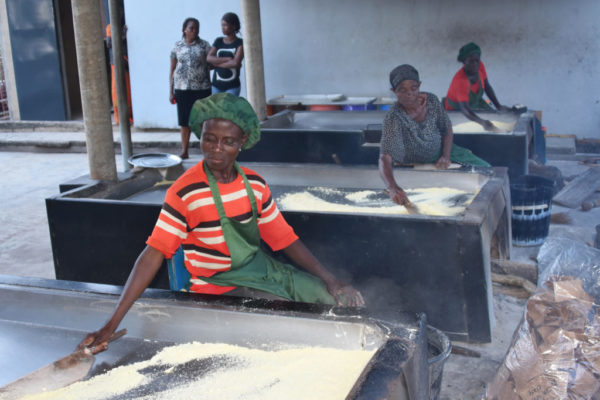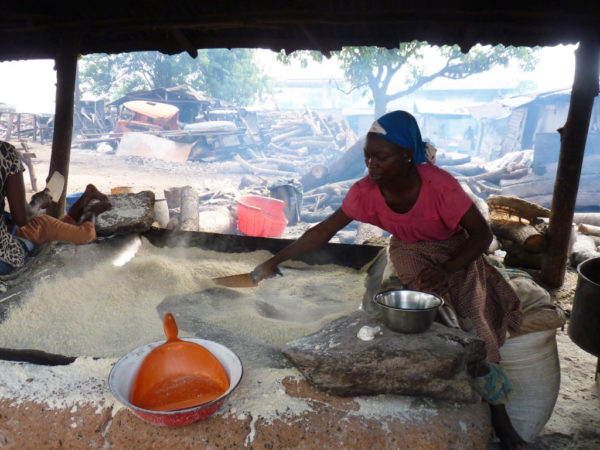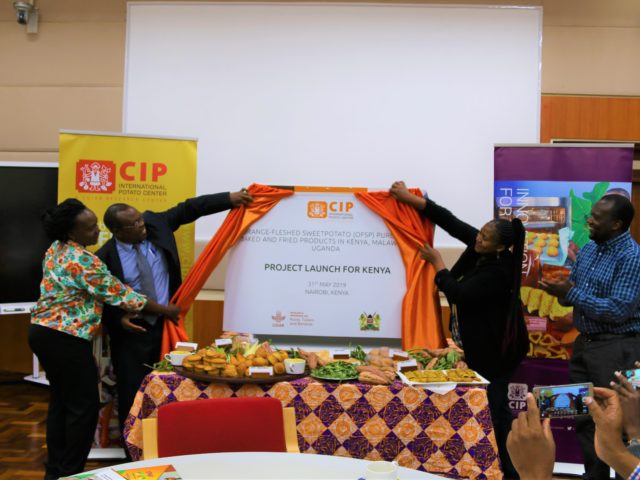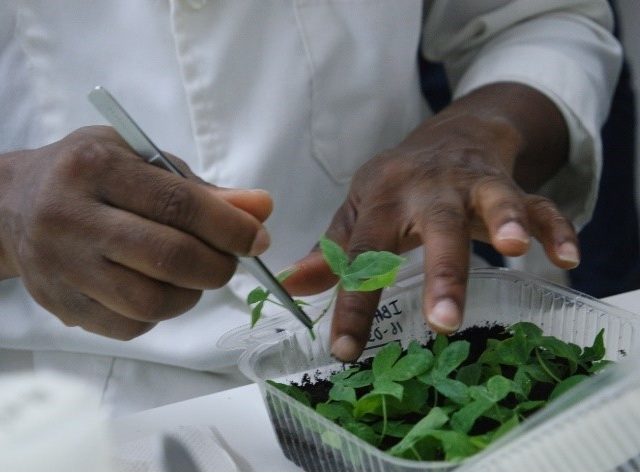Gari is a staple food for millions of West Africans, particularly in Nigeria where its production exceeds 9 million tons a year, and employs hundreds of thousands of people – especially women and children.
Made from cassava, gari is a creamy-white granular flour with a slightly sour taste that is most commonly eaten either by being soaked in cold water together with ingredients such as sugar or roasted groundnuts, or as a paste (eba) made with hot water.
Cassava deteriorates rapidly after harvesting so processing into gari makes an excellent, safe and storable convenience food. It has a lot of potential for feeding rapidly growing urban populations.
The process of turning cassava roots in to gari involves numerous labor-intensive steps including grating the peeled, washed cassava roots and leaving the material to ferment for several days, slowly pressing the fermented mash to remove excess liquid, sieving and then frying and stirring on a large metal pan often over a wood fire. Gari processing itself is largely in the hands of women in small local facilities and represents an important source of income and employment for them.
This process uses locally made, robust and simple equipment. However, it is not very efficient – around five tons of fresh roots are needed to produce one ton of gari and peeling the cassava by hand, a job mainly performed by women, is very time consuming. It also requires large quantities of firewood to roast the gari, and the smoke and general working conditions is a significant health issue for the women involved. The process also generates liquid waste from pressing the gari and heaps of waste peels which are an environmental hazard.
However, there is also a small but growing group of larger modern enterprises which are producing packaged gari using mechanized equipment for peeling, grating and frying.
To establish a detailed roadmap of the actions needed to meet the growing demand for safe and nutritious gari whilst balancing income and employment generation for men, women and youth, the ‘Gari Revolution in Nigeria: Roadmap to an Efficient and Equitable Gari Processing System’ meeting took place in Ibadan, Nigeria, from October 4 – 6, 2016.
Led by the Global Cassava Partnership for the 21st Century (GCP21) supported by the CGIAR Research Program on Roots, Tubers and Bananas (RTB), the meeting brought together policy makers, scientists and experts from the Nigerian Federal Ministry of Agriculture and Rural Development (FMARD), the International Institute of Tropical Agriculture (IITA), the Natural Resources Institute (NRI) and the International Cooperation Center for Research on Agronomic Development (CIRAD) along with many other partners in Nigeria with participants from Ghana and Uganda as well.

Women working in IITA’s model gari processing centre. Frying gari is one of the last steps in the process. Photo D.Dufour
“Because gari is regularly consumed by millions of Nigerians every day, and with cities projected to grow so fast we need to have a ‘gari revolution’. This will involve addressing many challenges simultaneously,” said Dr. Claude Fauquet, Director of GCP21.
“If the ‘gari revolution’ is successful we can reposition gari as a food of the future. It can play a key role as a locally produced source of much needed carbohydrates. It is also an excellent vehicle to improve human nutrition both in Nigeria and West Africa. While gari itself provides much needed carbohydrates, it has a relatively low protein, mineral and vitamin content, and there is the potential to enhance this by adding a supplement or through biofortification,” he explained.
Dr. Busie Maziya-Dixon, Senior Scientist, Food and Nutrition, IITA agrees, adding: “Gari provides essential carbohydrates and is an essential part of people’s diets. We are keen to explore options to make it even more nutritious. This is one of the key areas the workshop discussed: How do we improve the nutritional quality of gari without changing the texture and taste which the Nigeria population love so much? And what steps should be undertaken to make this a reality?”
The safety and environmental aspects of gari processing were also major topics of discussion during the workshop, and are of concern to Dr. Acho Okike, Senior Agricultural Economist at the International Livestock Research Institute (ILRI) who added: “We really need to get to grips with safety and working conditions in the processing environment which could give cassava a bad name! Collecting and transforming cassava peels into high quality animal feed will be a major first step.”

From L-R, Sanni Lateef (Federal University of Agriculture, Abeokuta), Graham Thiele (RTB), Peter Kulakow (IITA), Busie Maziya-Dixon (IITA) and Claude Fauquet (GCP21). Photo G.Aster/IITA
The workshop built on earlier work supported by RTB’s Flagship Project 4 (FP4) on ‘Nutritious RTB Foods and Value Added Through Post-Harvest Innovation’.
“In FP4 we paid particular attention to the small and medium enterprises where women play a major role. Stakeholders mapped the impact pathway from research on gari including incremental improvements to the processing technology of small processers, protocols for define product quality and waste management, through to livelihood improvements for cassava producers, processors and consumers. The intention is that different partners will use that pathway to improve collaboration and track impact,” said Dr. Graham Thiele, RTB Program Director.
The workshop report will be available shortly. Key lessons include:
- While gari is already an excellent food product, we need to enhance it to better provide equitable income, food and nutrition security in the context of population growth and urbanization.
- We need to identify more clearly the cassava varieties and traits which are suitable for gari and communicate that much better to all those involved in the gari value chain to ensure improved varieties are appropriate for processing.
- Whilst gari is usually a safe food, there are safety and hygiene issues involved that must be addressed.
- A dual pronged approach is required to progressively upgrade the capability and equipment of small-scale producers while supporting the larger enterprises as well.
- Fabricators and processors must be engaged in a process of co-innovation of equipment, and the progressive upgrading of equipment must involve access to microfinance and information as well as technology.
- There is an important aspect of gender equity linked to adoption, appropriate and affordable equipment for the women involved in small enterprises.
- All of these changes need empowered organizations, and we need to enhance farmers’ and processors’ voices, so that stakeholders are involved in the process of defining what changes are desirable in gari processing.
- Above all, a clear case must be made to policy makers in order to allocate attention and resources to implement all proposed changes




